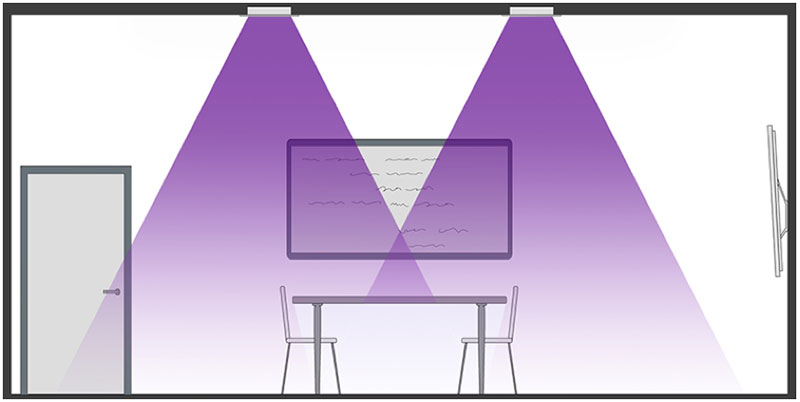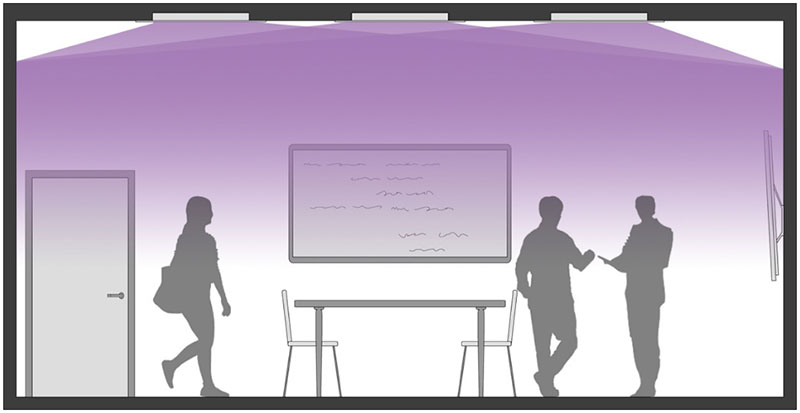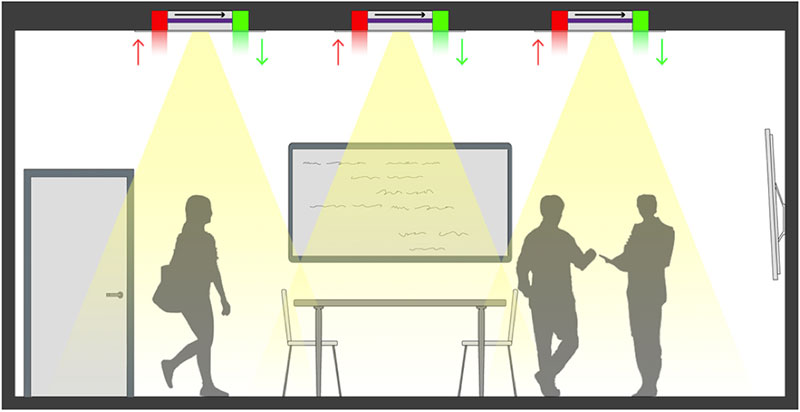Advertisement articles published in the LD+A eReport do not necessarily reflect the views of the IES nor do they represent an endorsement by the IES.
Sponsored By: Acuity Brands Lighting
By Jeannine Wang, PE LC, Director, Technology Solutions – Acuity Brands Lighting
How ultraviolet light (UV) works as a disinfection technology depends upon the wavelength(s) being employed. The UVC band with a wavelength of 200-280nm has emerged as a highly viable solution for interior architectural settings such as offices, retail settings and schools, due to its proven effectiveness against both bacteria and viruses.
Also, UVC is straightforward to apply in a defined area and its predicted effectiveness can be predetermined within a set of application design parameters and in reference to measured output data and laboratory test data. When an adequate dose is applied, UVC light can treat an area quickly. Utilizing UVC pathogen control can reduce the amount of chemicals that need to be used for disinfection purposes.
When evaluating a space for application of a UV disinfection solution, there are several UVC-specific technologies to consider:
- 1. Intense Room Disinfection Technology (using 254nm UVC wavelength) and Upper Room Disinfection Technology (using 254nm UVC wavelength)
In general, UV technology solutions that use the 254nm UVC wavelength work well. This wavelength can effectively inactivate many common viruses and bacteria and it can be cost-effective to implement. This UV technology solution usually works with legacy fluorescent luminaires (and newer LED lighting systems).
The 254nm Intense Room Disinfection approach cannot be used in a space while occupied due to concerns over injuries that can be caused by exposure of human skin and eyes to the 254nm UVC. Typically, this technology application would be used in the evening time or during off hours of room usage, in an hour-plus-long dose, to help control pathogens in the room.
Spaces: Operating rooms, school restrooms, gym workout rooms, teacher breakrooms and other high touch areas that can be treated while occupants are not present.
For the Upper Room Air Disinfection approach using 254nm UVC lamps, the UV light is aimed toward the ceiling, helping to treat the air that is circulating through the room. Although the UV light addresses the circulating air above the occupants’ heads, it does not treat any of the surfaces below eye level in the space. While this technique does allow for the system to operate while occupants are present, assuming a 9 ft. ceiling height or higher, additional caution during commissioning is imperative to make sure any occupants are protected against UV overexposure from either direct or reflected 254nm UVC light. This approach is generally less obtrusive than the Intense Room Disinfection (254 nm) approach, but it is often more expensive on per-square-foot basis in comparison.
Spaces: Auditoriums, waiting rooms, medical clinics, public gathering spaces, gym workout rooms, classrooms, and other high touch areas that can be treated while occupants are present.
- 2. Intense Room Disinfection Technology (using pulsed xenon lamps)
Another solution is the Intense Room Disinfection approach using pulsed xenon-based technology, which is a relatively new type of UV disinfection technology. This approach is similar to the Intense Room Disinfection solution using 254nm UVC light, but is not as obtrusive when not in use, as the technology fits more easily into various fixtures and spaces. The pulsed xenon lamps have wavelengths ranging from 200nm up to 1,000nm, and they are exceptionally powerful. With the broad band coverage in UVA, UVB and UVC bands and high output, pulsed xenon is very fast-acting (typically used in a 30 minute cycle time) against many pathogens. Solutions that use pulsed xenon lamps can be considered for unoccupied spaces only.

Spaces: Operating rooms, school restrooms, gym workout rooms, teacher breakrooms and other high touch areas that can be treated while occupants are not present.
- 3. Continual Room Disinfection Technology (using filtered 222nm UVC) and Luminaire Onboard Air Disinfection Technology (using targeted 254nm lamps).
A third approach to UV disinfection incorporates the filtered far-UVC light (222nm wavelength) in a Continual Room Disinfection solution. A primary difference in this approach is that laboratory studies suggest that filtered 222nm far-UVC does not pose a health risk for human eyes and have shown that this wavelength does not pose a health risk to human skin when used within appropriate parameters, which allows it to be applied throughout the day and night in occupied or unoccupied spaces for continual pathogen control.
To clarify, it is continual pathogen control and not continuous, meaning that this technology application can be turned on and off every few minutes on a regular cadence so as to remain within safety guidelines while providing ongoing pathogen control. For example, every three minutes or every six minutes this type of UVC light can be applied and occupants can have the freedom to work throughout that space at any time of day or night.

Finally, Luminaire Onboard Air Disinfection technology is an offshoot of the 254nm solutions that provides a more targeted approach. It uses an enclosed fixture to take in air from the immediate surrounding area and run it through its own filtration with a 254nm lamp with UV emissions fully contained inside. The luminaire then pushes that treated air back into the room. This approach is more localized to where pathogens are potentially introduced into a space. Therefore, it is able to treat the air and turn it over numerous times per hour right in the space where the occupants are located. It is also safer for occupants than other 254nm solutions because they are not directly exposed to the 254nm wavelength whatsoever.

Spaces: Offices, conference rooms, restrooms, house of worship, restaurants, retail, classrooms, and other high-occupancy spaces while occupants are present.
While UV technology offers effective solutions for reducing harmful pathogens in architectural spaces, it is not a perfect solution. It can do a lot of the heavy lifting to provide pathogen control, but the technology needs to be used in conjunction with chemical and mechanical cleaning disinfection protocols to help ensure thorough disinfection. And because it is not a perfect solution, there are other aspects to consider in the overall strategies for spaces that would like to use germicidal UV as a way to help make spaces safer for the public.
Please go to UV light disinfection technology for more information.
*All references to “disinfection” are referring generally to the reduction of pathogenic bioburden and are not intended to refer to any specific definition of the term as may be used for other purposes by the U.S. Food and Drug Administration or the U.S. Environmental Protection Agency. The disinfection technology as incorporated in Acuity Brands products is not for use as or for medical devices. Reduction of the pathogenic bioburden is a function of fixture run time and the distance to the UV light source and/or other factors and the level of reduction will vary within a specific space.

